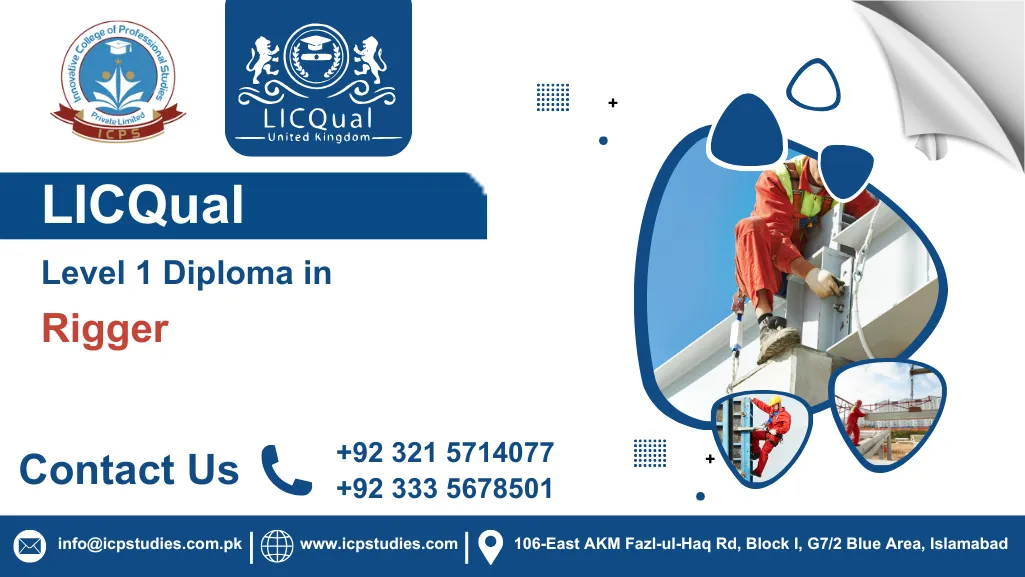The LICQual Level 1 Diploma in Rigger is an introductory training program designed to provide learners with the fundamental knowledge and practical skills required for safe rigging operations. This diploma focuses on building a strong foundation in equipment handling, basic safety practices, and workplace awareness. Learners are introduced to essential rigging concepts through structured modules that combine theoretical instruction with practical demonstrations. The program is ideal for individuals starting their careers in construction, engineering, logistics, or industrial environments, ensuring they gain the confidence and competence needed to perform rigging tasks responsibly.
This course is carefully designed to cover the basics of rigging operations, including equipment selection, inspection, load management, and hazard awareness. Learners will develop an understanding of how to prepare and execute rigging tasks while following safety standards and industry guidelines. Practical exercises are integrated to reinforce theoretical knowledge, allowing participants to apply their skills in real workplace scenarios. The diploma also emphasizes teamwork and communication, preparing learners to work effectively alongside crane operators, slingers, and supervisors. By focusing on safety and efficiency, the program ensures learners are well-prepared for entry-level rigging responsibilities.
The LICQual Level 1 Diploma in Rigger is recognized as a valuable certification across industries where lifting and rigging are essential. While not Ofqual regulated, it adheres to international training standards and provides learners with a respected credential. Participants with related certifications or diplomas, such as the LICQual Level 2 Diploma in Lifting Operations or Certificate in Construction Safety, will find this program an excellent starting point to enhance their expertise. Completion of the diploma demonstrates a learner’s commitment to workplace safety, technical competence, and professional growth in one of the most vital operational roles within industrial and construction environments.
All About LICQual Level 1 Diploma in Rigger
Course Overview
The LICQual Level 1 Diploma in Rigger is an introductory program designed to provide learners with essential knowledge and practical skills in rigging operations. It emphasizes safety, basic equipment handling, and workplace awareness, preparing participants to perform rigging tasks responsibly across construction, engineering, logistics, and industrial environments.
This diploma is structured into 6 total units, each focusing on fundamental aspects of rigging. Learners explore equipment selection, inspection, load management, hazard awareness, and teamwork. The curriculum ensures a balanced mix of theory and practice, enabling participants to apply their knowledge confidently in workplace scenarios while adhering to industry safety standards.
With 24 credits assigned, the program reflects its academic value and professional recognition. Credits highlight the structured learning required to achieve competence at this level. Learners are assessed through practical demonstrations and theoretical evaluations, ensuring they meet professional standards while demonstrating applied skills in safe and efficient rigging practices.
The LICQual Level 1 Diploma in Rigger requires 60 Guided Learning Hours (GLH), offering a concise yet impactful training experience. This duration allows learners to absorb key concepts while gaining practical exposure. Completion of the diploma provides a respected certification, enhancing career prospects and demonstrating competence in rigging operations across multiple industrial sectors.
To enroll in the LICQual Level 1 Diploma in Rigger, learners are expected to meet basic requirements that ensure readiness for introductory training and workplace safety.
- Age Requirement: Learners should generally be 16 years or older to demonstrate maturity and responsibility in workplace settings.
- Educational Background: A basic level of secondary education is recommended. Related certifications or diplomas such as Lifting Operations, Certificate in Construction Safety, or Diploma in Industrial Skills can provide a useful foundation.
- Language Proficiency: Learners must have a basic command of English to understand course materials, safety instructions, and workplace communication.
- Work Experience: No prior work experience is required, though exposure to construction, logistics, or industrial environments can be beneficial.
These requirements ensure learners are adequately prepared to succeed in the program and apply their skills confidently in entry-level rigging operations.
The LICQual Level 1 Diploma in Rigger is designed for individuals seeking to build foundational knowledge and skills in rigging operations. It is suitable for those starting their careers or looking to gain formal certification in safe and efficient rigging practices.
Construction and Site Workers
- Individuals beginning careers in construction and site operations
- Workers responsible for assisting in lifting and rigging tasks
- Those seeking formal certification to validate entry-level rigging skills
- Employees aiming to improve safety awareness on construction sites
- Learners wishing to strengthen their technical credibility
Engineering and Industrial Staff
- Personnel entering mechanical or civil engineering projects
- Workers supporting rigging operations in factories or plants
- Staff learning equipment inspection and basic maintenance
- Employees requiring structured training in rigging methods
- Teams needing certified riggers for compliance and safety standards
Logistics and Warehousing Assistants
- Workers handling cargo and goods in warehouses
- Staff coordinating lifting and moving operations
- Employees ensuring safe storage and transportation of materials
- Supervisors training entry-level logistics staff
- Professionals aiming to enhance operational efficiency and safety
Oil, Gas, and Energy Sector Entrants
- Workers starting in offshore or onshore rigging operations
- Staff learning to manage heavy equipment in energy projects
- Employees responsible for assisting in safety-critical load handling
- Teams requiring certified riggers for compliance with industry standards
- Individuals seeking career growth in energy and industrial sectors
Career Starters and New Entrants
- Individuals entering construction or industrial fields for the first time
- Learners seeking practical, hands-on introductory training
- Those aiming to build technical expertise in rigging operations
- People interested in safety-focused certifications and diplomas
- Career starters looking for recognized professional qualifications
Supervisors and Trainers
- Managers overseeing entry-level lifting and rigging operations
- Supervisors ensuring compliance with safety regulations
- Leaders responsible for guiding and training new staff
- Professionals seeking to validate their supervisory expertise
- Staff aiming to strengthen leadership credibility in technical roles
Study Units
- Introduction to Rigging
- Basic Rigging Equipment
- Basic Lifting Techniques
- Health & Safety in Rigging
- Communication and Signaling
- Rigging Operations in the Field
Learning Outcomes
By the end of this course, learners will be able to:
Introduction to Rigging
- Understand the fundamental concepts and principles of rigging.
- Identify the key components involved in rigging operations and their functions.
- Demonstrate knowledge of the role and responsibilities of riggers in various industries.
- Explain the importance of rigging in construction, manufacturing, and other industries.
Basic Rigging Equipmen
- Identify and describe various types of rigging equipment (e.g., slings, hooks, shackles, and pulleys).
- Demonstrate the proper use, inspection, and maintenance of rigging equipment.
- Understand how to select the appropriate equipment for specific rigging tasks based on load type and conditions.
- Recognize the importance of ensuring that rigging equipment meets safety standards.
Basic Lifting Techniques
- Understand the basic principles behind safe and effective lifting techniques.
- Demonstrate correct lifting and load securing methods to prevent accidents and damage.
- Recognize the importance of load balancing and stability during lifting operations.
- Apply proper lifting techniques when moving and positioning loads in a controlled manner.
Health & Safety in Rigging
- Understand the key health and safety regulations applicable to rigging operations.
- Identify potential hazards and risks involved in rigging tasks.
- Implement appropriate safety measures, including the use of personal protective equipment (PPE).
- Recognize the significance of conducting risk assessments and adhering to safe rigging practices to prevent accidents.
Communication and Signaling
- Understand the importance of clear communication and signaling during rigging operations.
- Demonstrate proficiency in using standard hand signals and verbal communication techniques.
- Ensure effective communication between riggers, crane operators, and other personnel involved in the operation.
- Apply proper signaling techniques to maintain safety and coordination during lifting operations.
Rigging Operations in the Field
- Apply theoretical knowledge of rigging in real-world field operations.
- Demonstrate practical rigging techniques for handling and securing loads in various environments.
- Work effectively in a team to complete rigging operations while ensuring safety protocols are followed.
- Adapt rigging techniques to site-specific conditions, addressing challenges such as weather or uneven terrain.
FAQs About LICQual Level 1 Diploma in Rigger

